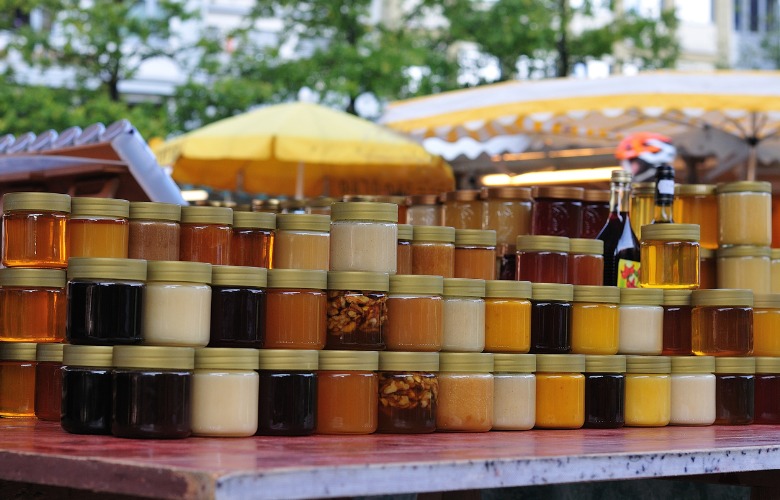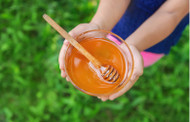What Are The Health Benefits of Honey?
Posted by Jemile Nesimi Hobson, B.A. on Oct 12, 2024
Honey is a sweet thick golden liquid made by bees that are produced from the nectar of flowers. Honey is best-known by the honeybees that make it and is sweet because it contains monosaccharides fructose and glucose. Honey has been used by humans for thousands of years and has a rich traditional history. Honey also has many health benefits and the pollination that takes place to make it is crucial to almost every fruit, vegetable or plant there is. Let’s find out why and what is possibly putting it in jeopardy.
The Health Benefits of Honey
Honey is a natural sweetener and can be a healthier option to sugar. It is a delicious addition to all kinds of food and your cup of tea. Did you know that it can be used for medicinal purposes?
1 Aids Wound Healing
Honey has antibacterial properties that may heal burns if applied topically according to a study.
2 Reduces Acid Reflux
Studies show that honey can reduce the upward flow of stomach acid because it helps to line the stomach and esophagus. This can be helpful for those with GERD or gastroesophageal reflux disease-causing symptoms like inflammation, heartburn and acid reflux.
3 Kills Bacteria
With antibacterial properties, honey contains a protein called defensin-1 that can kill bacteria. Manuka honey is a kind of honey that can prevent the bacteria from Clostridium difficle from staying in the body.
4 Relieves Cold and Cough Symptoms
Honey can be used as a natural cough remedy and has been approved by the American Academy of Pediatrics as a cough treatment. According to Penn State College of Medicine children over one year didn’t cough at night as much and slept better when they had honey with an upper respiratory infection.
Note: Never give an infant 12 months or younger honey as it can cause a severe type of food poisoning called botulism. This is because wild honey contains a potential source of C, botulinum spores. Even a tiny taste can be very dangerous.

Traditional Use of Honey
Honey is sweet, organic and has an indefinite shelf-life, no wonder it has been loved by so many for so long. Honey was mentioned back in 2100 B.C. by Babylonians and Sumerians. However, it dates back further, to a rock painting 8000 years ago of someone harvesting honey. Honeycombs have been discovered by Archaeologists in Egypt buried with pharaohs in tombs. The honey? Still edible and delicious after so many years.
“The land of milk and honey” is referred to Israel where God gave Jacob honey. It is mentioned many other times within the Old Testament, the Talmud, and the Quran. The Romans healed wounds with honey and Hannibal fed his army on it. Mead drank by the Kings and Queens of long ago, is fermented honey wine. Finally, in Germany, honey and beeswax were used as commerce as peasants used it to pay feudal lords.
It is believed that humans discovered honey over 10,000 years ago and the sweetness was so good they never stopped mentioning it in their writings across the world. Sweeter than fruit and seemingly that of the Gods. Honey is used in cooking often as a sweetener, on crackers, with tea, and used as a marinade. Also, it can be used in soap or lip balm. Beeswax is also useful and often used to make candles.
Honey has many varieties and they can differ in taste:
- Acacia – sweet and classic
- Alfalfa – light and floral
- Blackberry – fruity and rich
- Blueberry – fruity and tangy
- Clover - floral and sweet
- Eucalyptus – menthol
- Heather – bitter and pungent
- Orange Blossom – citrus and floral
- Tupelo – very sweet and mild
- Wildflower – fruity and light

Honeybees in Danger
The work of the honeybees is hard work, that is where we get the saying “Busy as a Bee”. Honeybees flying from flower to flower is a familiar and relaxing image. Honey that little hungry bears go searching for is the stuff of children’s stories. There is more to the bee than our human observances.
Bees live in complex social systems that work in very tight-knit communities that benefit one another. Honeybees are considered super pollinators that assist plants and flowers to reproduce. Bees land on a flower and the stamen (the male reproductive part of a flower) sticks to the bee’s hair or in their pollen basket. Then the bee carries the pollen to another flower and it touches the pistil (the female reproductive part of a flower). This allows for fertilization. This symbiotic relationship works well – the bee gets nectar and pollen to make honey and the flower can reproduce. One-third of all the foods that we eat wouldn’t exist without bees! That is a lot of food. Almonds, apples, blueberries, cherries, avocados, onions, cucumbers, oranges, pumpkins and grapefruit are all foods that we couldn’t have without bees.
The bees are disappearing, and no one is sure why it is happening. In 2006, beekeepers discovered that entire colonies of bees would disappear[JNH1] at the same time – however, the queen bee and immature bees would be left. This is called Colony Collapse Disorder or CCD. CCD is complicated and there has been a study of multiple factors (approx. 62) and nothing seemed to be a single cause. They did find that disease-causing organisms called pathogens can be to blame, or a group of stressors. Exposure to pesticides, lack of diversity genetically, and poor nutrition have also been sighted as possible causes.
Protecting honeybee health has been an important part of beekeepers' work. They need to keep their businesses by saving the colonies. They can do this by improving the colony health and their ability to survive. They can start to do this by taking samples, in 2019 the Sentinel Apiary Program “took 2,221 samples from 461 colonies in 85 apiaries”. They could then see if when they lost a colony what had happened. Most often it was due to Queen Failure and Varroa, with a handful of others due to other issues.
Poor Nutrition for bee larvae has been found that they grow into smaller adult honeybees with shorter life spans. They also had impaired productivity and performance as pollinators.
Honeybee Starvation can be caused by several things like long-distance transportation, bad weather or diseases. Overharvesting can also be a cause and beekeepers need to be careful that the colony doesn’t lose too much of their honey store. Pesticide's toxic effect can be amplified when starvation occurs.
Poor Weather can cause honey shortages when the weather is to wet for too long, especially in the winter months. Management Error is due to the experience of a beekeeper and can impact the beehive greatly. Beginners are encouraged to talk to more experienced beekeepers and join beekeeping organizations on how to take care of a hive including the time of feeding, requeening, splitting, and pest control treatments.
Varroa destructor is a parasitic mite that has been a colony killer across the globe. Pesticides have been used, but the mites are growing resistance and sometimes the chemicals used can do more damage such as queens that won’t lay eggs anymore and worker bees killing barren queens.
Queen Failure is queen bees seem to be living shorter lives, sometimes the worker bees killing their queens is occurring. This is called supersedure, a natural part of a hives life is happening faster, and it is stressing hives. There are theories of why this may be happening from insecticide and fungicide exposure which have killed queen larva in the honeycomb cells. Also, it is found that the miticide is decreasing the amount of sperm the queen has that is meant to last her life is running out in only 2 or 3 years.

How can we help save the honey?
The honeybee population has a loss of 40% since 2006 when it began being tracked in the United States. The rest of the world is having similar drops from the UK to China.
So how can we help repopulate the bees?
- Buy organic. Insecticides can cause honeybee populations to drop. Buying organic means you are supporting better farming practices that are less harmful to the bees.
- Gardening. same as above – use organic practices in your own garden
- Bee Flowers. plant flowers that bees love – pale purple coneflower, common yarrow, sunflowers, blue giant hyssop, horsemint, purple coneflower, black-eyed Susan, Asters, Joe-Pye weeds, and goldenrods.
- Plant trees. Did you know that bees get a lot of nectar from tree blooms? They are also a great bee habitat.
- Bee bath. Bees take breaks and want a cool drink of water too after a long day of pollinating. Put out a birdbath or small bowl with water.
- Support beekeepers. Buying locally-made honey and beeswax from a local beekeeper is a great way to support bees
- Find a bee organization that you can support and learn more about saving bees.











